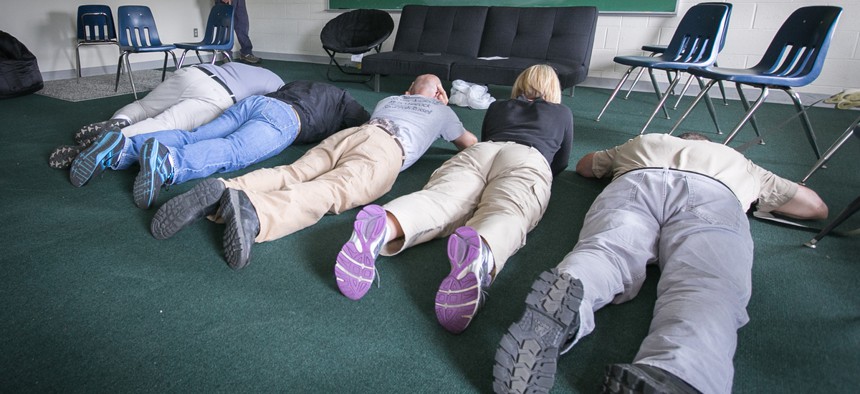Teachers Unions Urge End of Active-Shooter Drills that Can Traumatize Students

School employees play dead on the floor during an active shooter mock scenario in Rittman, Ohio, in June 2014. Shutterstock
In a new report, two teachers unions and a gun-control group recommend that schools stop using active-shooter drills—or at least revise them—amid fears the exercises are terrifying and damaging to students.
Safety drills that mimic the experience of an active school shooter can traumatize students and negatively impact their academic performance and mental and physical health, two teachers’ unions and a gun safety organization said in a report released this week.
The report recommends that schools do away with active-shooter drills altogether in favor of more comprehensive safety plans that include threat assessment training and access to mental health services.
“Research shows that school climate is one of the biggest predictors of school violence,” says the report, released by the National Education Association, the American Federation of Teachers and the Everytown for Gun Safety Support Fund, an advocacy group. “School climate encompasses the relationships, values, and structures that enable students to learn in a safe, respectful, and nurturing environment. Investing in increased social support and mental health services can assist students, especially those experiencing emotional or social difficulties, in receiving the help they may need.”
Lockdown and active-shooter drills became common in schools after the Columbine High School shooting in 1999, and have increased in frequency since then. According to data from the federal Department of Education, 95% of public schools held some type of safety drill in the 2015-2016 school year, up from 40% a decade before.
But despite their ubiquity, there is little data on the effectiveness of active-shooter training, while researching the topic is difficult due to the wide variation of drills conducted across different school systems and states. There are no universal “best practices” for drills. At least 40 states mandate them.
States laws typically don't specify the kind of drills that schools should conduct, leaving it up to school officials to decide what to do.
“Students and educators are required to participate in drills that vary dramatically across America’s schools, from some that involve advanced parental notification of trauma-sensitive developmentally appropriate exercises to others that deploy ‘masked gunmen’ actors, require students as young as 3 and 4 years old to be confined within a space for extended periods, and fail to inform children that they are in a drill until it is over," the report says.
But there is evidence that the drills can traumatize students and make it difficult for them to learn. Last month, for example, administrators at a school in Cincinnati failed to warn teachers and students that an active-shooter drill would be taking place, leading to mass panic when the principal announced there was an intruder in the building.
“At no time did I hear the word ‘drill,'” Kristan Sterling, a teacher at the Academy of Multilingual Immersion Studies, told a local news station.“My students—I teach seventh and eighth grade—at that point began physically jumping on top of one another to get themselves into a corner.”
Mental health professionals have warned about the effects of similar situations, noting that the exercises can have both “short- and long-term consequences on school performance and physical and mental health.”
“What these drills really do is potentially trigger either past trauma or trigger such a significant physiological reaction that it actually ends up scaring the individuals instead of better preparing them to respond in these kinds of situations,” Melissa Reeves, former president of the National Association of School Psychologists, told NPR in 2019.
Given those risks, the report says, schools should rethink the use of active shooter drills for students. If schools wish to continue with safety drills, the groups recommend a number of steps to protect students’ well-being, including giving parents advance notice of drills, announcing the drills to teachers and students before they begin, eliminating any simulations that mimic an actual active shooter, and “tracking data about the efficacy and effects of drills.”
Most importantly, the report says, drills should not be schools’ only line of defense against the threat of an active shooter.
“If schools decide to adopt these drills, they must be part of a comprehensive safety plan that includes measures to prevent active shooter incidents from happening in the first place, such as threat assessment programs, access to mental health professionals, collaborating with law enforcement, and engaging the community to ensure guns are not easily accessible,” the report concludes.
Kate Elizabeth Queram is a Staff Correspondent for Route Fifty and is based in Washington, D.C.
NEXT STORY: The nation's commitment to AI will power the future of smart cities





